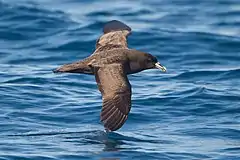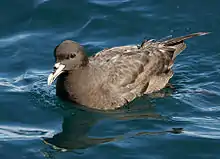White-chinned petrel
The white-chinned petrel (Procellaria aequinoctialis) or Cape hen,[3] is a large shearwater in the family Procellariidae. It ranges around the Southern Ocean as far north as southern Australia, Peru and Namibia, and breeds colonially on scattered islands.
| White-chinned petrel | |
|---|---|
 | |
| Scientific classification | |
| Kingdom: | Animalia |
| Phylum: | Chordata |
| Class: | Aves |
| Order: | Procellariiformes |
| Family: | Procellariidae |
| Genus: | Procellaria |
| Species: | P. aequinoctialis |
| Binomial name | |
| Procellaria aequinoctialis | |
Taxonomy
The white-chinned petrel is a member of the genus Procellaria, and in turn is a member of the family Procellariidae, and the order Procellariiformes. As a member of the Procellariiformes, they share certain identifying features. First, they have nasal passages that attach to the upper bill called naricorns. Although the nostrils on the petrel are on top of the upper bill. The bills of Procellariiformes are also unique in that they are split into between seven and nine horny plates. They produce a stomach oil made up of wax esters and triglycerides that is stored in the proventriculus. This can be sprayed out of their mouths as a defence against predators and as an energy rich food source for chicks and for the adults during their long flights.[4] Finally, they also have a salt gland that is situated above the nasal passage and helps desalinate their bodies, due to the high amount of ocean water that they imbibe. It excretes a high saline solution from their nose.[5]
Etymology
Procellaria comes from two Latin words, procella "storm" and arius "pertaining to", with reference to the birds' association with stormy weather. The word petrel is derived from Saint Peter and the story of his walking on water, referring to their appearing to run on the water's surface when taking to the air.[6]
Description

The white-chinned petrel measures 51–58 cm (20–23 in) in length, weighs 0.97–1.89 kg (2.1–4.2 lb) and spans 134–147 cm (53–58 in) across the wings. Not only is it the largest Procellaria petrel but is also the largest species in its family outside of the giant petrels.[7][8] This large petrel is sooty-black and has some white on its throat and chin, more so in the Indian Ocean sector than the Atlantic. Its primaries can have a silvery appearance underneath. Its bill may be horn or yellow with a black tip, and also black between the nostrils. It has black feet.[3] When it flies, it mixes slow wing beats with glides. Although normally quiet, it will rattle or groan while at its colony.[2]
| Location | Population | Date | Trend |
| South Georgia | < 2,000,000 pairs | 2004 | Decreasing 28% per 20 years |
| Antipodes Island | 100,000+ pairs | 2000 | |
| Disappointment Island | 100,000+ pairs | 2000 | |
| Kerguelen Islands | 175,000-226,000 pairs | 1989 | |
| Crozet Islands | 23,600 pairs | 1989 | Decreasing 37% per 21 years |
| Campbell Islands exc. Campbell Island | 10,000+ pairs | ||
| Falkland Islands | 55 pairs | ||
| Prince Edward Island | Decreasing 14.5% per year | ||
| Auckland Islands | |||
| Total | 7,000,000 | 2004 | Decreasing 30% to 49% per 60 yr |
Behaviour
Range and habitat
The white-chinned petrel utilises many islands during the breeding season. 2,000,000 pairs breed on South Georgia, Between 175,000 and 226,000 pairs are on the Kerguelen Islands, and 100,000 pairs on Disappointment Island. Some also breed on the Crozet Islands, Prince Edward Islands, Campbell Islands, Auckland Islands, Antipodes Islands, and the Falkland Islands. During the non-breeding season, the petrels fly from the Antarctic pack ice to the subtropics.[2]
Conservation
A 2004 estimate placed the adult population at 7,000,000 with an occurrence range of 44,800,000 km2 (17,300,000 sq mi). Mortality of both adults and chicks due to longline fisheries has caused the IUCN to classify it as vulnerable.[1] An overall decline in population is inferred by a drop in burrow occupancy rates of 28% at Bird Island, and an 86% reduction in population at Prydz Bay. Also, monitoring on Marion Island has shown of 14.5% reduction, and a 37% reduction on the Crozet Islands.[2] Unintentional death at the hands of longline fisheries has proven to be a major contributor to the overall population decline. Nearly all of the bycatch from the Namibian hake are white-chinned petrels. 10% of the South African pelagic longline bycatch and 55% of the demersal. Also, the white-chinned petrel has suffered at the hands of invasive species such as the brown rat, Rattus novegicus, and the black rat, Rattus rattus.[2]
Several of the breeding islands are protected areas. Ongoing studies and population monitoring are occurring at South Georgia, the Prince Edward Islands, Kerguelen Islands, and Crozet Islands. Finally, they are a part of ACAP Annex I, and CMS Appendix II.[2]
To assist in reversing the decline in population it has been proposed to continue and extend monitoring studies, trying to eliminate most invasive species, promote adoption of best practice mitigation measures at all fisheries within the range via ACAP, FAO, CCAMLR.[2]
Footnotes
- BirdLife International (2012). "Procellaria aequinoctialis". IUCN Red List of Threatened Species. 2012. Retrieved 26 November 2013.CS1 maint: ref=harv (link)
- BirdLife International (2009)
- ZipCode Zoo (19 Jun 2009)
- Double, M. C. (2003)
- Ehrlich, Paul R. (1988)
- Gotch, A. T. (1995)
- Archived 2011-10-30 at the Wayback Machine (2011).
- CRC Handbook of Avian Body Masses by John B. Dunning Jr. (Editor). CRC Press (1992), ISBN 978-0-8493-4258-5.
- Berrow, S. & Croxall, J. (1999)
- N. Huin (1994)
- Cherel, Y, et al. (1996)
- Maynard, B. J. (2003)
References
- Berrow, S.; Croxall, J. (1999). "The Diet of white-chinned petrels Procellaria aequinoctialis, Linnaeus 1758, in years of contrasting prey availability at South Georgia" (PDF). Antarctic Science. 11 (3): 283–292. Bibcode:1999AntSc..11..283B. doi:10.1017/s0954102099000371.
- BirdLife International (2009). "White-chinned Petrel - BirdLife Species Factsheet". Data Zone. Retrieved 28 Jul 2009.
- Cherel, Y.; Weimerskirch, H.; Duhamel, G. (1996). "Interactions between longline vessels and seabirds in Kerguelen waters and a method to reduce seabird mortality". Biological Conservation. 75 (1): 63–70. doi:10.1016/0006-3207(95)00037-2.
- Double, M. C. (2003). "Procellariiformes (Tubenosed Seabirds)". In Hutchins, Michael; Jackson, Jerome A.; Bock, Walter J.; Olendorf, Donna (eds.). Grzimek's Animal Life Encyclopedia. 8 Birds I Tinamous and Ratites to Hoatzins. Joseph E. Trumpey, Chief Scientific Illustrator (2nd ed.). Farmington Hills, MI: Gale Group. pp. 107–111. ISBN 0-7876-5784-0.
- Ehrlich, Paul R.; Dobkin, David, S.; Wheye, Darryl (1988). The Birders Handbook (First ed.). New York, NY: Simon & Schuster. pp. 29–31. ISBN 0-671-65989-8.
- Gotch, A. F. (1995) [1979]. "Albatrosses, Fulmars, Shearwaters, and Petrels". Latin Names Explained A Guide to the Scientific Classifications of Reptiles, Birds & Mammals. New York, NY: Facts on File. p. 192. ISBN 0-8160-3377-3.
- Huin, N. (1994). "Diving Depths of White-Chinned Petrels". Condor. 96 (4): 1111–1113. doi:10.2307/1369125. JSTOR 1369125.
- Maynard, B. J. (2003). "Shearwaters, petrels, and fulmars (Procellariidae)". In Hutchins, Michael; Jackson, Jerome A.; Bock, Walter J.; Olendorf, Donna (eds.). Grzimek's Animal Life Encyclopedia. 8 Birds I Tinamous and Ratites to Hoatzins. Joseph E. Trumpey, Chief Scientific Illustrator (2nd ed.). Farmington Hills, MI: Gale Group. pp. 123–133. ISBN 0-7876-5784-0.
- ZipCode Zoo (19 Jun 2009). "Procellaria aequinoctialis (White-Chinned Petrel)". BayScience Foundation. Archived from the original on 2009-01-08. Retrieved 22 Jul 2009.
External links
| Wikimedia Commons has media related to Procellaria aequinoctialis. |
- Whitechinned Petrel - Species text in The Atlas of Southern African Birds.
